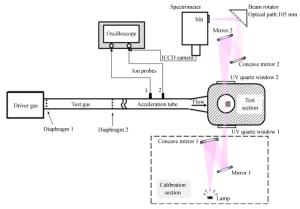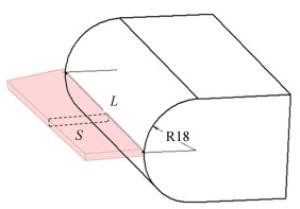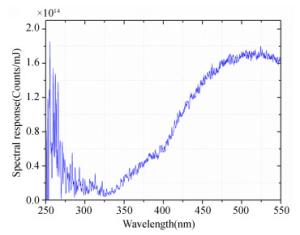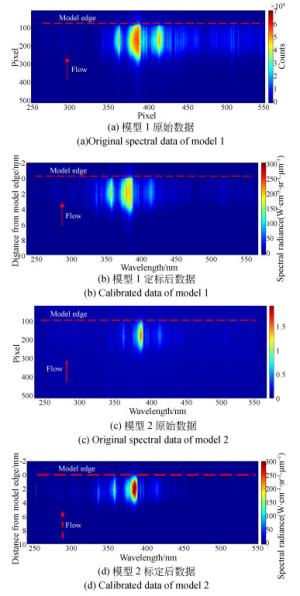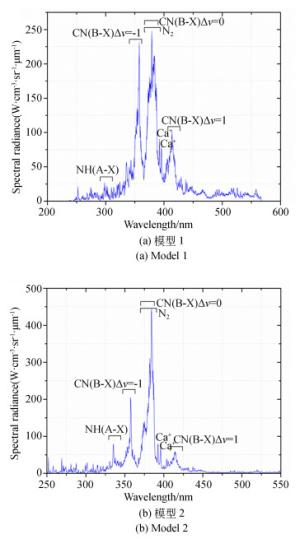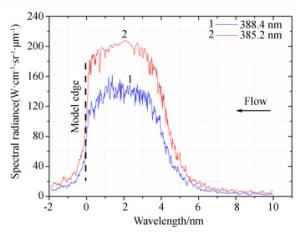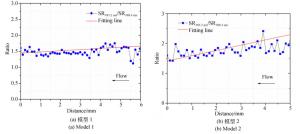-
摘要: 利用膨胀管对宽度为45 mm和90 mm的半圆柱模型进行了地球再入高超声速流动试验,再入速度为8 km/s。试验利用配有ICCD相机的光谱仪,测量了具有空间分辨的激波后辐射光谱,光谱范围为250~550 nm,得到了沿流体方向的激波辐射轮廓线。分析发现在该光谱范围内辐射主要为CN(B-X)带系分子光谱。利用卤钨灯对该波段光谱进行定标,得到了激波层辐射的绝对辐射亮度。通过采用两种模型辐射亮度对模型宽度归一化后发现,绕流场高温气体辐射存在较强的自吸收现象,同时观测到了绕流场激波的三维效应。通过实验发现,CN(B-X)Δv=0带系的3-3振动带系385.2 nm波长位置和0-0带系388.4 nm波长位置辐亮度之比随着流场靠近模型边缘而逐渐下降,这表明激波层内辐射的动态非平衡特征。Abstract: An expansion tube facility was operated using two half-cylinder models with width of 45 mm and 90 mm respectively for producing high-enthalpy flows at the nominal velocity of 8 km/s relevant to Earth reentry. Spatially resolved emission spectroscopy in the wavelength range from 250 nm to 550 nm behind a shock wave was recorded by a spectrometer with ICCD camera. Shock wave stagnation streamline was observed along the flow direction. It is found that the spectrum are dominated by the CN(B-X) violet band. A halogen tungsten lamp was used to realize calibration and the absolute radiation luminance of the shock layer was obtained. By comparing the model widths normalized by two kinds of model radiances, it can be found that there is a strong self-absorption of high temperature gas radiation around the flow fluid. In addition, three-dimensional effect was observed. It can be found that the ratio between spectral radiance at 385.2 nm in the CN(B-X) violet 3-3 band and spectral radiance at 388.4 nm in the CN(B-X) violet 0-0 band is decreasing along the distance toward the model edge. The results illuminated that dynamical non-equilibrium features exists in the shock layer along the distance of the model edge.
-
Key words:
- expansion tube /
- hypersonic flow /
- absolute radiation measurement
-
表 1 初始参数和测量条件
Table 1. Initial parameters and test conditions
Parameters Values Gas Driver gas pressure/MPa 1.0 H2, O2 Test gas/Pa 3000 Air Acceleration gas/Pa 20 Air Velocity/km·s-1 8 - Total enthalpy/MJ·kg-1 36 - -
[1] LIEBHART H, HERDRICH G, FASOULAS S. Advances for radiation modeling for earth re-entry in PARADE: application to the STARDUST atmospheric entry, AIAA-2012-3196[R]. New orleans, Louisiana: AIAA, 2012. [2] GRINSTEAD J H, JENNISKENS P, CASSELL A M, et al.. Airborne observation of the hayabusa sample return capsule reentry, AIAA-2011-3329[R]. Honolulu, Hawaii: AIAA, 2011. [3] HERMANN T, LÖHLE S, ZANDER F, et al... Characterization of a reentry plasma wind-tunnel flow with vacuum-ultraviolet to near-infrared spectroscopy[J]. Journal of Thermophysics and Heat Transfer, 2016, 30(3):673-688. doi: 10.2514/1.T4695 [4] PORAT H, MORGAN R G, MCINTYRE T J. Study of radiative heat transfer in Titan atmospheric entry[C]. Proceedings of 28th International Congress of the Aeronautical Sciences, Launceston, 2012. [5] JOHNSTON C O, GNOFFO P A, MAZAHERI A. Influence of coupled radiation and ablation on the aerothermodynamic environment of planetary entry vehicles[J]. RTO Lecture Series, Von Karman Inst. for Fluid Dynamics, Rhode-St-Genèse, Belgium, 2013, 218:1-36. http://www.wanfangdata.com.cn/details/detail.do?_type=perio&id=gT/9jUxQkZ4dHqaZcqmM81P8hfii4jsZ36qGwGItmT0= [6] BRANDIS A M, JOHNSTON C O. Characterization of stagnation-point heat flux for earth entry AIAA-2014-2374[R]. Atlanta: AIAA, 2014. [7] GUPTA R N. Aerothermodynamic analysis of stardust sample return capsule with coupled radiation and ablation[J]. Journal of Spacecraft and Rockets, 2000, 37(4):507-514. doi: 10.2514/2.3592 [8] GNOFFO P A, JOHNSTON C O, KLEB B B. Challenges to computational aerothermodynamic simulation and validation for planetary entry vehicle analysis, NASA RTO-EN-AVT-186[R]. Washington: NASA, 2010. [9] JACOBS P, MORGAN R, BRANDIS A, et al.. Design, operation and testing in expansion tube facilities for super-orbital re-entry[C]. STO-AVT-VKI Lecture Series Radiation and Gas-Surface Interaction Phenomena in High Speed Re-Entry (2013-AVT-218). 2013: 5-1-5-65. https://espace.library.uq.edu.au/view/UQ:326742 [10] JACOBS C M, MCLNTYRE T J, MORGAN R G, et al.. Radiative heat transfer measurements in low-density titan atmospheres[J]. Journal of Thermophysics and Heat Transfer, 2015, 29(4):835-844. doi: 10.2514/1.T4519 [11] HOLLIS B R, STRIEPE S A, WRIGHT M J, et al.. Prediction of the aerothermodynamic environment of the huygens probe. AIAA-2005-4816[R]. Toronto: AIAA, 2005. [12] PARK C. Nonequilibrium Air Radiation (NEQAIR) Program: User's Manual, NASA-TM-86707[R]. Washington: NASA, 1985. [13] THOMAS G M, MENARD W A. Experimental measurements of nonequilibrium and equilibrium radiation from planetary atmospheres[J]. AIAA Journal, 1966, 4(2):227-237. doi: 10.2514/3.3423 [14] GÖKÇEN T. N2-CH4-Ar chemical kinetic model for simulations of atmospheric entry to Titan, AIAA-2004-2469[R]. Portland: AIAA, 2004. [15] BOSE D, WRIGHT M J, BOGDANOFF D W, et al.. Modeling and experimental assessment of CN radiation behind a strong shock wave[J]. Journal of Thermophysics and Heat Transfer, 2006, 20(2):220-230. doi: 10.2514/1.16869 [16] LABRACHERIE L, BILLIOTTE M, HOUAS L. Shock-tube analysis of argon influence in Titan radiative environment[J]. Journal of Thermophysics and Heat Transfer, 1996, 10(1):162-168. doi: 10.2514/3.767 [17] LEWIS S W, MORGAN R G, MCINTYRE T J, et al.. Expansion tunnel experiments of earth reentry flow with surface ablation[J]. Journal of Spacecraft and Rockets, 2016, 53(5):887-899. doi: 10.2514/1.A33267 [18] SHEIKH U A, MORGAN R G, MCINTYRE T J. Vacuum ultraviolet spectral measurements for superorbital earth entry in X2 expansion tube[J]. AIAA Journal, 2015, 53(12):3589-3602. doi: 10.2514/1.J054027 [19] SHEIKH U A, JACOBS C, LAUX C O, et al.. Measurements of radiating flow fields in the vacuum ultraviolet[C]. Proceedings of the 29th International Symposium on Shock Waves, Springer, 2013: 653-658. [20] BRANDIS A M, MORGAN R G, MCINTYRE T J, et al.. Nonequilibrium radiation intensity measurements in simulated Titan atmospheres[J]. Journal of Thermophysics and Heat Transfer, 2010, 24(2):291-300. doi: 10.2514/1.44482 [21] 杨乾锁, 余西龙, 姜乃波, 等.激波波后氮分子发射光谱的测量[J].流体力学实验与测量, 2000, 14(3):57-60+65. doi: 10.3969/j.issn.1672-9897.2000.03.011YANG Q S, YU X L, JIANG N B, et al.. Spectral measurement of nitrogen emission behind normal shock wave[J]. Experiments and Measurements in Fluid Mechanics, 2000, 14(3):57-60+65. (in Chinese) doi: 10.3969/j.issn.1672-9897.2000.03.011 [22] 杨虹, 张雅声, 丁文哲.飞艇红外探测系统探测高超声速目标性能研究[J].中国光学, 2016, 9(5):596-605. http://www.chineseoptics.net.cn/CN/abstract/abstract9447.shtmlYANG H, ZHANG Y SH, DING W ZH. Detectability of airship infrared detection system to hypersonic vehicle[J]. Chinese Optics, 2016, 9(5):596-605. (in Chinese) http://www.chineseoptics.net.cn/CN/abstract/abstract9447.shtml [23] 孟凡胜, 熊仁生, 刘朝晖.高速再入体热辐射模型的分析与修正[J].光学 精密工程, 2006, 14(8):574-578. http://d.old.wanfangdata.com.cn/Periodical/gxjmgc200604009MENG F SH, XIONG R SH, LIU CH H. Analysis of hypersonic reentry radiation model[J]. Opt. Precision Eng., 2006, 14(8):574-578. (in Chinese) http://d.old.wanfangdata.com.cn/Periodical/gxjmgc200604009 [24] LIN X, YU X L, LI F, et al.. Measurements of non-equilibrium and equilibrium temperature behind a strong shock wave in simulated martian atmosphere[J]. Acta Mechanica Sinica, 2012, 28(5):1293-1302. http://www.wanfangdata.com.cn/details/detail.do?_type=perio&id=lxxb-e201205008 [25] BRANDIS A M, GOLLAN R J, SCOTT M P, et al.. Expansion tube operating, conditions for studying nonequilibrium radiation relevant to Titan aerocapture, AIAA-2006-4517[R]. Sacramemto: AIAA, 2006. -





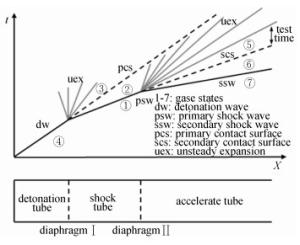
 下载:
下载:
